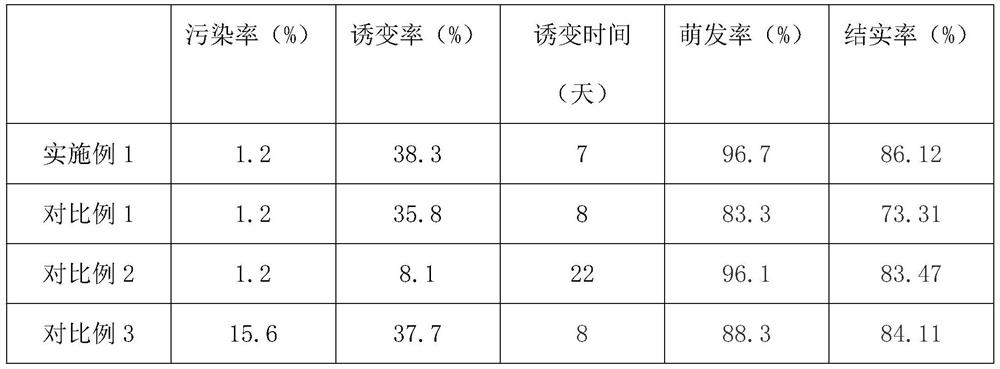Affloridae haworthia succulent plant polyploidy plant cultivation formula
A technology for succulents and succulents, which is applied in the field of formulas for cultivating polyploid plants of succulents belonging to the genus succulents of the Afuhua family, can solve the problems of long time consumption and low mutagenesis rate.
- Summary
- Abstract
- Description
- Claims
- Application Information
AI Technical Summary
Problems solved by technology
Method used
Image
Examples
Embodiment 1
[0020] Embodiment 1 A formula for cultivating polyploid plants of the succulent plant of the genus Aphidaceae, comprising:
[0021] 1. Induction medium formula: prepared with distilled water, in which MS is the basic medium, add colchicine 0.015g / L, sucrose 30g / L, agar 9g / L, 6-benzylaminopurine 0.002g / L, 1-naphthalene Acetic acid 0.001g / L and sodium benzoate 0.75%, adjust the pH to 5.4-6.0;
[0022] Two, explant preparation: select the succulent blade that grows adventitious root, its surface is not damaged, and root system development is good.
[0023] 3. Inoculate the explants in the induction medium: inoculate the explants on the induction medium on a clean workbench, and seal it.
[0024] 4. Illumination culture: place the inoculated and sealed explants in a 20-degree light culture room for 7-20 days.
[0025] 5. Natural cultivation: After the leaves grow 1-2cm seedlings, the polyploid seedlings are naturally cultivated.
Embodiment 2
[0026] Embodiment 2 A formula for cultivating polyploid plants of the succulents of the genus Aphidaceae Twelve, comprising:
[0027] 1. Induction medium formula: prepared with distilled water, in which MS is the basic medium, add colchicine 0.01g / L, sucrose 20g / L, agar 7g / L, 6-benzylaminopurine 0.0005g / L, 1-naphthalene Acetic acid 0.0005g / L and sodium benzoate 0.5%, adjust the pH to 5.4-6.0;
[0028] Two, explant preparation: select the succulent blade that grows adventitious root, its surface is not damaged, and root system development is good.
[0029] 3. Inoculate the explants in the induction medium: inoculate the explants on the induction medium on a clean workbench, and seal it.
[0030] 4. Illumination culture: place the inoculated and sealed explants in a 20-degree light culture room for 7-20 days.
[0031] 5. Natural cultivation: After the leaves grow 1-2cm seedlings, the polyploid seedlings are naturally cultivated.
Embodiment 3
[0032] Embodiment 3 A formula for cultivating polyploid plants of the succulents of the genus Aphidaceae Twelve, comprising:
[0033] 1. Induction medium formula: prepared with distilled water, in which MS is the basic medium, add colchicine 0.01g / L, sucrose 25g / L, agar 8g / L, 6-benzylaminopurine 0.02g / L, 1-naphthalene Acetic acid 0.0005g / L and sodium benzoate 0.5%, adjust the pH to 5.4-6.0;
[0034] Two, explant preparation: select the succulent blade that grows adventitious root, its surface is not damaged, and root system development is good.
[0035] 3. Inoculate the explants in the induction medium: inoculate the explants on the induction medium on a clean workbench, and seal it.
[0036] 4. Illumination culture: place the inoculated and sealed explants in a 20-degree light culture room for 7-20 days.
[0037] 5. Natural cultivation: After the leaves grow 1-2cm seedlings, the polyploid seedlings are naturally cultivated.
PUM
 Login to View More
Login to View More Abstract
Description
Claims
Application Information
 Login to View More
Login to View More - R&D
- Intellectual Property
- Life Sciences
- Materials
- Tech Scout
- Unparalleled Data Quality
- Higher Quality Content
- 60% Fewer Hallucinations
Browse by: Latest US Patents, China's latest patents, Technical Efficacy Thesaurus, Application Domain, Technology Topic, Popular Technical Reports.
© 2025 PatSnap. All rights reserved.Legal|Privacy policy|Modern Slavery Act Transparency Statement|Sitemap|About US| Contact US: help@patsnap.com


